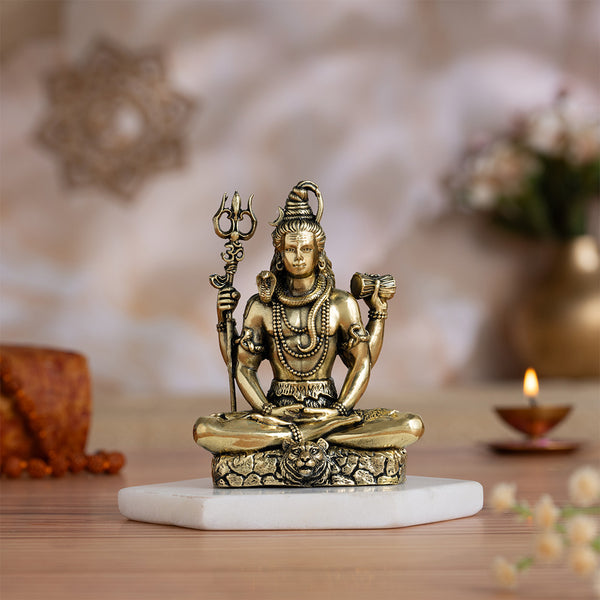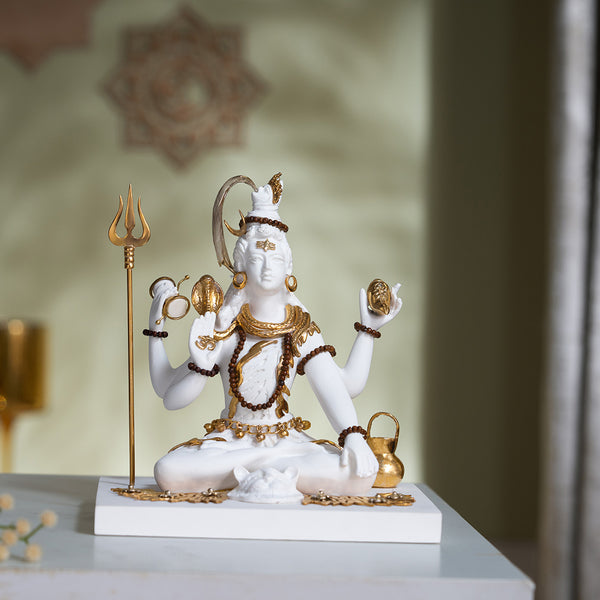Considered to be the greatest God in the history of Hinduism, tales of Lord Shiva have been hailed and revered from time immemorial. Part of the Holy Trinity, Lord Shiva is often credited as the Lord of Destruction.
The Hindu trinity, known as the Trimurti, consists of Brahma, known as the Creator, Vishnu, known as the Preserver, and Lord Shiva, revered as one of the most powerful gods in Hinduism, as the Lord of Destruction.
It is believed that the cycle of creation and regeneration cannot persist without Lord Shiva playing his pivotal role in maintaining cosmic balance.

Brass Lord Shiva Meditating Idol (4 Inch)
According to the Shaivite tradition, Shiva is considered the invincible, Absolute Being, beyond both dualities and limitations. He is described as self-born and beyond origination in some texts, while others mention Shiva's parents. However, the essence is that Shiva transcends conception and human notions of lineage.
Lord Shiva is believed to be a source of benefits and protection for his devotees. He is worshipped across India and the world in various forms and manifestations.
Devotees worship Lord Shiva's idols in different forms like Bhairava, Adiyogi, and Dakshinamurti. These murtis, venerated as embodiments of Shiva's presence, help devotees connect with his divine attributes and powers.
Goddess Parvati is often depicted alongside Lord Shiva. While the sons of Lord Shiva are known to all, Lord Shiva’s daughters are spoken of little.
This article would be looking into who is lord shiva's daughter and the names of Mahadev’s daughters.
Daughters Of Lord Shiva And Goddess Parvati
Ashoka Sundari or Bala Tripura Sundari

Ashokasundari, or Ashoka Sundari, is a Hindu goddess and the daughter of Lord Shiva and Devi Parvati. She is also known as Lavanya, Anvi, Bala Tripura Sundari, and Viraja.
The name Ashoka alludes to the alleviation of Parvati's sorrow (shoka), while the name Sundari refers to her beauty. In South India, she is worshipped as Bala Tripurasundari.
Parvati wished for a daughter, Ashokasundari, from the wish-fulfilling tree Kalpavriksha, so that she might feel less lonely.
According to one version of the Nahusha legend, Parvati once begged Shiva to accompany her to the world's most exquisite garden.
Shiva complied with Parvati's request and escorted her to Nandanvana, where she beheld the Kalpavriksha tree, rumoured to grant desires. As a mother, Parvati suffered great loss and isolation after her son Kartikeya grew up and left Kailash.
To alleviate her isolation, she wished for a daughter from the magical tree. Ashokasundari was born when she wished for it.
Ashokasundari, Parvati said, would one day wed the lunar dynasty's Nahusha, whose power would rival that of the heavenly ruler Indra.
Despite her widespread worship in Gujarat, little is known about this Goddess beyond the legend that she was present when Shiva severed Ganesha's head.
According to the legend, she took refuge behind a salt bag during the moment.
Since then, Ashokasundari has been linked to salt, representing the everlasting flavor of life and the fact that without it, life would be tasteless.
Jyoti

Jyoti, or the Hindu goddess of light and the "Vel," is revered by Hindus. As the goddess of "vel," she is closely linked to her brother, Lord Murugan, the son of Shiva and Parvati.
The birth of this goddess, the daughter is Lord Shiva has several myths and legends to her name. According to the first legend, she is the materialization of Shiva's grace as a child.
Similarly to how Lord Muruga is said to have been formed from six sparks from Lord Shiva's forehead, Goddess Jyoti is said to have been born from a spark from Goddess Parvati's forehead in the second myth.
Goddess Parvati uses her to create the weapon Shakti Vel, which she then gives to her son. Lord Muruga uses it to vanquish the demon Surapadman.
All of the temples dedicated to her brother Lord Muruga have the belief that Goddess Jyoti exists in the formless or arupa realm. Lord Nataraja, a manifestation of Shiva, is said to be her father, and she is the flame he carries.
During the waxing and waning of the moon, the mother Manonmani, her husband (Shiva in the form Sadisiva), and their daughter Jyoti reside in the Ajna cakra in our foreheads, as described by the sage Agastya in his major devotional poem, Shodasam.
The sage continues his story by explaining how Jyoti sprang from the Pranava pillar of 'OM.’ Saravanabhavai is the name of the goddess, and her Vel form is revered in various Muruga temples.
Saravanabhavai is her name, and it indicates that she has an inseparable bond with Saravana or Muruga. She is venerated as the goddess Rayaki, who is linked to the Vedic Raka, in several regions of India. She is worshipped as the goddess Jwalaimukhi in the northern part of India.
Manasa

The tale of Manasa is the most fascinating. The reigning deity of the snake family is believed to be Manasa, daughter of Shiva.
The Puranas state that Manasa's mother, the serpent Kadru, conceived at Shiva's touch and gave birth to the goddess.
Manasa is a well-known Bengali goddess who often takes the form where she is adorned with snakes, either seated on a lotus or perched on another snake.
Seven cobras' heads form a canopy over her head, protecting her from the sun. She is sometimes shown holding a baby. It's supposed that the kid is her son, Astika.
Manasa is portrayed as compassionate towards her worshippers but ruthless towards others. Manasa's terrible temper is attributed to her rejection at the hands of her father, her husband, and her stepmother Parvati.
There is no image of Manasa used in her devotion. Images of Manasa are also worshipped with more traditional goddess symbols like a branch of a tree, an earthen pot, or a snake figure.
She is greatly revered for her protection against snake bites, as well as contagious diseases like smallpox and chickenpox.
Manasa has the largest devoted following in Bengal, where she is honored by her devotees worshipping her in temples. During monsoon, when there are increased sightings of snakes, the goddess is held in high esteem.
Manasa is also a major fertility deity, and her blessings are sought out during marriage and in cases of infertility, especially among the lower classes.
Throughout Bengal, she is revered and named Neto, also known as Neta, Netidhopani, Netalasundori, etc.
5 Daughters Of Lord Shiva According To Shiv Puran
Another popular legend, this one from Shiv Puran states that Lord Shiva has five daughters. Parvati and Shiva were once engaged in a playful time in the water.
This union ended with Lord Shiva ejaculating. Lord Shiva gathered his semen on a leaf. This led to him fathering five female offspring. Yet these young women weren't human, they were Nagakanyaas.
While Lord Shiva was aware of their existence, Goddess Parvati wasn’t.
Lord Shiva cherished his daughters. Shiva often met his daughters at the lake first thing in the morning. Mother Parvati's curiosity about Mahadev's everyday whereabouts was piqued when he regularly disappeared in the mornings.
One day, Goddess Parvati followed Lord Shiva to the lake. After witnessing Lord Shiva be fatherly towards the Nagakanyaas, Parvati became enraged. Her foot was about to strike one of the girls when Shiva intervened and reminded her that the girl was also her daughter.
Goddess Parvati heard the complete tale of how girls were created by Shiva.

Premium White & Gold Plated Shiva Statue With Trishul
Conclusion
Thus, are the five daughters of Lord Shiva. Though not as revered and well-known as his sons, each of his daughters has their own unique legend weaved around their existence.
The story of their birth and creation varies from place to place, however, there are devout worshippers of each of these devis.







